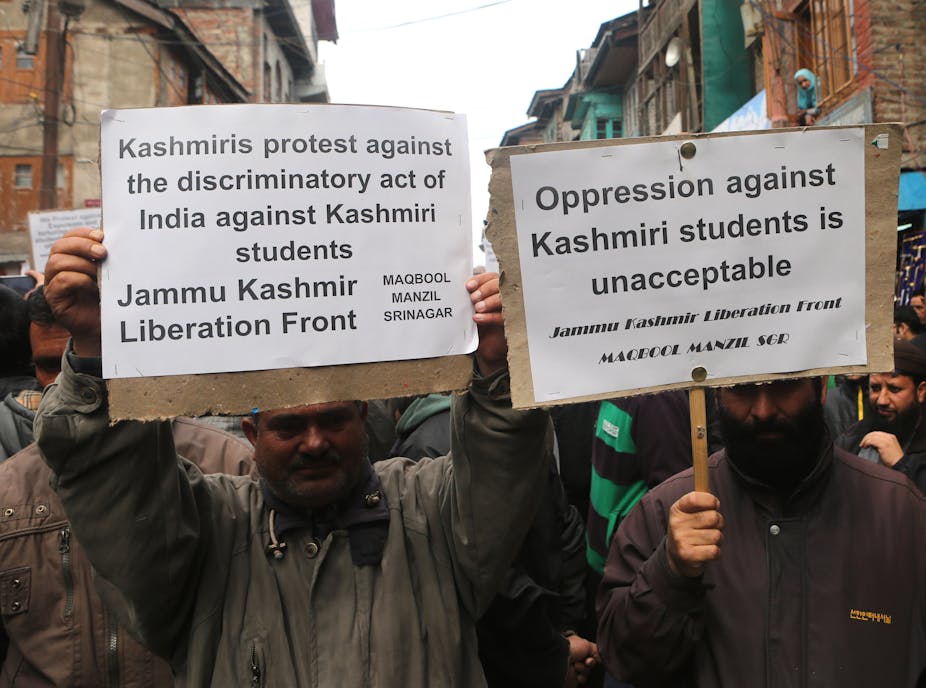The seven million people living in the Kashmir Valley have a distinctive regional identity. Now the Valley’s continuing estrangement from the rest of India has sparked a peculiar incident on the campus of a privately run university in Meerut in northern India’s Uttar Pradesh province.
The Valley is the most populous of three distinct regions that together make up Jammu & Kashmir (J&K), one of the 29 states of India. J&K has about three-quarters of the population of a larger territory which has been disputed between India and Pakistan since 1947. The rest of this territory’s population live across the “Line of Control”, in two regions in Pakistan known there as “Azad (Free) Kashmir” and the “Northern Areas”.
On 2 March, students on the campus of the Swami Vivekanand Bharti University in Meerut were watching the live television broadcast of a one-day cricket match between the national teams of India and Pakistan being played in Dhaka, the capital of Bangladesh, as part of an international tournament known as the Asia Cup. The entire subcontinent is, of course, passionate about cricket.
The students were a mix of locals and non-locals, the latter including scores of students from the Kashmir Valley enrolled at the university. Meerut is a city of about one million people located just 50 miles north-east of Delhi, India’s national capital.
Pakistan narrowly won the match, and then things took an ugly turn. Arguments and scuffles broke out between some Kashmiri students and other students, who accused the students from the Valley of cheering for Pakistan during the match and celebrating its victory (and India’s defeat). A few Kashmiri students reportedly shouted “Pakistan Zindabad” (Long Live Pakistan) after the game ended.
Charges of sedition
As with all brawls, there are different accounts of what exactly transpired, and who was responsible for the escalation. Some of the Kashmiri students have said they were in fact cheering both teams during the game. It has been reported that the hostel rooms of some Kashmiri students were vandalised during the fracas.
The police were called, and initially some Kashmiri students were charged with sedition, as well as other offences. The sedition charge was dropped within days. The chief minister of J&K state, Omar Abdullah, a scion of the Valley’s most prominent political family, tweeted that the charge was unacceptably harsh.
Some 67 students from the Valley were taken under police escort to the city’s train and bus stations, from where they travelled back to the Valley. The university authorities have said this was necessary to avert the risk of further incidents, and some of the students’ parents have agreed that this was the wisest course of action to ensure their wards’ safety.
Angry reaction in the Valley
The events in Meerut have triggered protest meetings and demonstrations in the Valley. There the evicted students, who are in their late teens or early twenties, are seen as victims, not culprits. Meanwhile in Islamabad, a spokeswoman of Pakistan’s foreign ministry announced that “our hearts and our academic institutions are open [to the affected students]”.
Hafiz Saeed, the founder and spiritual leader of Lashkar-e-Taiba (“Army of the Pious”), an infamous Pakistani terrorist organisation, went further. He has offered scholarships on behalf of his movement to all 67 students to study anywhere in the world.
Youth sense of injustice
In reality, the vast majority of the Valley’s population rejects both Indian and Pakistani national identities. They subscribe to a Kashmiri identity, rooted in the Valley’s history, culture, and politics.
The Valley is overwhelmingly Muslim. A very large proportion of these people, possibly even the vast majority, feel estranged from India. This feeling of estrangement triggered a large-scale insurgency in the Valley from 1990. The insurgency raged for nearly a decade and a half, gradually abating only after 2003.

Nonetheless, simmering unrest has persisted and occasionally erupted. In 2010, the Valley was convulsed by a “stone pelters” uprising. For nearly four months, from mid-June to end-September, tens of thousands of stone-pelters, mostly teenage boys and young men in their twenties and thirties, engaged in daily pitched and running battles across the Valley with the local police and personnel of the Central Reserve Police Force (CRPF), paramilitary police under the authority of the government in New Delhi. About 120 protesters were shot dead in the confrontations, and about 1,500 others were seriously injured. Several hundred police and CRPF personnel were also injured.
The Valley’s people feel that they have been, and continue to be, oppressed under Indian authority. They believe that democratic freedoms and civil liberties have been largely denied to them for six decades, and that they are a people under a form of occupation.
This acute, widespread sentiment of oppression and grievance has been transmitted from generation to generation in the Valley since the 1950s. In the late 1980s and early to mid-1990s, a radicalised generation of young men resorted to armed struggle to confront Indian authority. That struggle eventually petered out during the last decade, after exacting a terrible cost in trauma and suffering from its participants and the Valley’s society.
While the guns have largely fallen silent, the anger has remained and is now expressed by a new generation whose weapon of choice is the stone rather than the Kalashnikov. The many thousands of young Kashmiri men and women of the post-insurgency generation who study in institutions of higher education and vocational training across India could be a bridge across the chasm that separates the Valley from mainstream India. Perhaps they are, in ways that don’t draw media attention.
But as long as mass resentment festers unaddressed in the Valley, incidents such as that in Meerut will occur. A different, better chapter in the relationship between the Kashmir Valley and the Indian Union requires a change of both mindset and policy in New Delhi.

